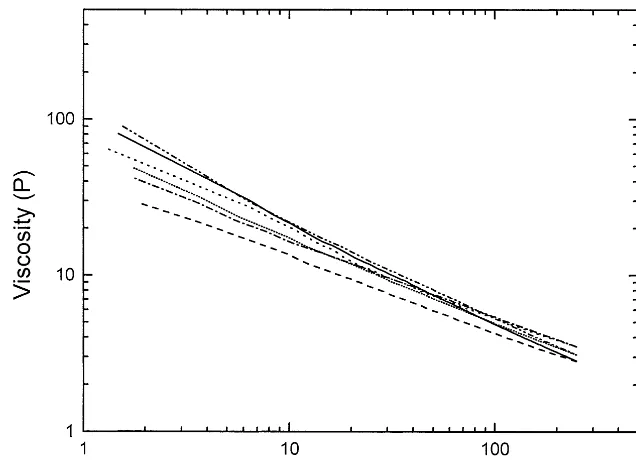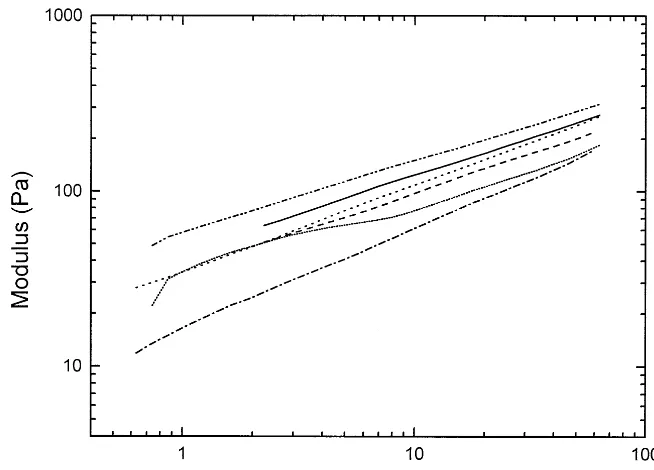Rheological characterization of jet-cooked
Lesquerella
fendleri
seed gum and cornstarch solutions
R.A. Holser
a,*, C.J. Carriere
b, J.S. Park
c, T.P. Abbott
aaNew Crops Research,National Center for Agricultural Utilization Research,Agriculture Research Ser6ice, US Department of Agriculture,1815North Uni6ersity Street,Peoria,IL61604,USA
bBiomaterials Processing Research,National Center for Agricultural Utilization Research,Agriculture Research Ser6ice, US Department of Agriculture,1815North Uni6ersity Street,Peoria,IL61604,USA
cNational Instrumentation Center for En6ironmental Management,Seoul National Uni6ersity,Suwon441-744,South Korea Accepted 8 October 1999
Abstract
Lesquerellais a potential new seed crop that contains hydroxy fatty acid triglycerides and approximately 15% seed coat gums. The polysaccharide gum of theLesquerella fendleriseed was isolated and jet-cooked with cornstarch in a series of laboratory experiments to investigate the viscoelastic properties of gum-modified starch solutions. The
Lesquerella gum was combined with cornstarch at 1, 5, and 10% levels to produce a jet-cooked and drum dried material with potential application as a thickening or suspension agent. Flow curves were determined for 1% solutions of jet-cooked starch and gum combinations. All materials investigated were biodegradable and exhibited positive thixotropic behavior. © 2000 Elsevier Science B.V. All rights reserved.
Keywords:New crops; Gums; Rheology; Viscosity modifier
www.elsevier.com/locate/indcrop
1. Introduction
Lesquerella fendleri is an emerging new crop with a polysaccharide seed coat gum that exhibits
positive thixotropic behavior in dilute solutions (Abbott et al., 1994). The seed oil contains a triglyceride composition with over 50% hydroxy fatty acids (Barclay et al., 1962; Mikolajcak et al., 1962; Roetheli et al., 1991; Abbott et al., 1997). As the production of L. fendleri increases to provide hydroxy fatty acids for the growing in-dustrial market, the supply of seed coat gums will also increase. To develop new applications for the available L. fendleri seed coat gum, we investi-gated the treatment of gum and cornstarch solu-tions in a jet-cooking process and evaluated the rheological performance of the resulting material.
Names are necessary to report factually on available data; however, the USDA neither guarantees nor warrants the stan-dard of the product, and the use of the name by USDA implies no approval of the product to the exclusion of others that may also be suitable.
* Corresponding author. Tel.: +1-309-6816533; fax: + 1-309-6816524.
E-mail address: [email protected] (R.A. Holser)
R.A.Holser et al./Industrial Crops and Products11 (2000) 243 – 247
244
2. Materials and methods
Food grade cornstarch, Buffalo 3401, was ob-tained from CPC International, Inc. (Argo, IL). The cornstarch density was reported to be 1.5 g ml−1with a specific heat of 0.31 cal g−1 °C, and
a moisture content of between 5 and 10%. L. fendleriseed coat gums were previously recovered from hexane extracted meal by water washing and freeze-drying (Carlson et al., 1992).
Solutions of cornstarch and Lesquerella gums were prepared separately in de-ionized water and sheared for 10 min in a Waring model CB-3 laboratory blender (Waring Products Corp., New York, NY) at a setting of medium. These corn-starch and Lesquerella solutions were then com-bined and mixed together in the laboratory blender for another 5 min to produce a homoge-neous mixture with a total solids of 15% (w/v). Following this procedure, solutions were prepared from cornstarch and 1, 5, or 10%Lesquerellagum to produce feed material to the jet-cooker with different compositions while maintaining a con-stant total solids content of 15%.
A Penick and Ford (Penford Products Co., Cedar Rapids, IA) laboratory jet-cooker was used to process the gum and cornstarch solutions. The jet-cooker was equipped with a type B, size 300 Hydro-heater (Hydro-Thermal Corp., Milwaukee, WI), and a model SSQ Moyno feed pump (Rob-bing and Myers Inc., Chicago, IL). The jet-cooker was operated at a feed rate of 1.8 l min−1. The
temperature of the cooker was held at 140°C with 275 kPa steam. Jet-cooked product was collected in a stainless steel Dewar flask. Samples of feed and product were taken for viscosity determina-tions. A rotary double drum dryer equipped with 30.5 cm diameter and 45.7 cm long drums was used to dry the jet-cooked materials (Drum Dryer and Flaker Corp., North Liberty, IN). The drum dryer was operated at a speed of approximately 2 rpm and heated to 143°C with 310 kPa steam. Drum dried material was milled to a fine powder using a model 3379 laboratory mill (Thomas Corp., Philadelphia, PA) fitted with a 1 mm screen.
Rheological characterizations were performed
with a controlled-stress rheometer (Model
CSL2500, CarriMed, Dorking, UK) equipped with a 6 cm, 2° cone fixture and a Peltier plate which enabled the temperature in the chamber of the instrument to be controlled to 90.2°C.
Thixotropic loop experiments were conducted over the shear rate range 0.8 – 250 s−1. The
up-ward and downup-ward cycles of the loop were kept equal, with a total cycle time of 4 min. Small-am-plitude, oscillatory frequency sweeps were con-ducted using a constant applied strain of 30% over an angular frequency range 0.1 – 100 rad s−1
. The strain amplitude was selected to provide a measurable level of torque for each material across the frequency range of interest. A torque sweep was conducted prior to the small-amplitude oscillatory frequency sweep experiments to deter-mine the linear viscoelastic range. This strain am-plitude was found to be within the linear viscoelastic range for each of the solutions tested. Experiments were replicated to provide agreement within 10% relative standard deviation.
3. Results and discussion
Fig. 1. Thixotropic loop measurements for cornstarch and 5% Lesquerella gum solutions determined at 25°C before and after jet-cooking. Feed,up cycle, down cycle; product,up cycle, down cycle.
R.A.Holser et al./Industrial Crops and Products11 (2000) 243 – 247
246
Fig. 3. Thixotropic loop determinations for 1% solutions of drum dried, jet-cooked mixtures of cornstarch andLesquerella gum determined at 25°C.Lesquerellagum (0%), — up cycle, - - - down cycle; 1%Lesquerellagum, up cycle, down cycle; 10% Lesquerellagum, up cycle, … down cycle.
Feed solutions prepared from cornstarch only, as a control, and cornstarch containing 1% Les -querella gum were also subjected to thixotropic loop experiments, but the solids did not remain suspended in solution. These data were not con-sidered reliable and were not reported (Chhabra, 1993).
The jet-cooked products were drum dried, milled, and redissolved in de-ionized water to a 1% solids concentration and characterized by thixotropic loop experiments and by small-ampli-tude oscillatory sweeps (Figs. 3 and 4). Fig. 3 shows the results for the first cycle of thixotropic loop experiments for samples of cornstarch, corn-starch with 1% Lesquerella gum and cornstarch with 10% Lesquerellagum. The addition of Les -querella gum did not appreciably change the be-havior of the jet-cooked material. This may be the result of drum drying the material, which could lead to degradation of the cross-links or modifica-tion of the gums. The addimodifica-tion ofLesquerellagum appears to have slightly diminished the positive
thixotropic response as the up and down curves for the Lesquerella containing materials are bounded above and below by the control (Fig. 3). Fig. 4 displays the results of oscillatory sweeps performed on solutions of these same materials. In each case, the viscous or loss modulus is the dominant response over the frequency range in-vestigated. Cornstarch with 1% Lesquerella gum shows greater deviation between the loss and stor-age modulus at the lower frequencies while
corn-starch with 10% Lesquerella gum shows
greater deviation at the higher frequencies. It is interesting to note that the values for the loss and storage modulus of the control is bounded above and below by cornstarch with 10% Lesquerella gum.
Fig. 4. Response of drum dried, jet-cooked mixtures of cornstarch andLesquerellagum to oscillatory shear in 1% solutions at 25°C in terms of storage modulus,G%, and loss modulus,G¦. Cornstarch with 0%Lesquerellagum, - - -G%, —G¦; cornstarch with 1% Lesquerellagum, G%, G¦; cornstarch with 10%Lesquerellagum, …G%, G¦.
.
4. Conclusions
Mixtures of cornstarch jet-cooked with 1, 5, and 10%Lesquerellagum produced materials with positive thixotropic properties and with a higher viscosity than mixtures of the same materials prior to jet-cooking. All of these materials
were biodegradable and offer potential as
viscosity modifiers in edible and industrial appli-cations.
References
Abbott, T.P., Wu, Y.V., Carlson, K.D., Slodki, M.E., Klei-man, R., 1994. Isolation and preliminary characterization ofLesquerella fendlerigums from seed presscake and defat-ted meal. J. Agric. Food Chem. 42, 1678 – 1685.
Abbott, P.P., Dierig, D.A., Foster, M.A., Nelson, J., Coates, W., Felker, F.C., Frykman, H.B., Carlson, K.D., Arquette,
J., 1997. Current status of Lesquerella as an industrial crop. Inform 8, 1169 – 1175.
Barclay, A.S., Howard, S.G., Jones, Q., 1962. The search for new industrial crops II:Lesquerella(Cruciferae) as a source of new oilseeds. Econ. Bot. 16, 95 – 100.
Carlson, K.D., Kleiman, R., Watkins, L.R., Johnson Jr, W.H., 1992. In: Naqvi, H.H., Estilai, L., Ting, I.P. (Eds.), New Industrial Crops and Products. Office of Arid Lands Studies, College of Agriculture, University of Arizona, Tucson, AZ, pp. 169 – 175.
Chhabra, R.P., 1993. Bubbles, Drops, and Particles in Non-Newtonian Fluids. CRC Press, Boca Raton, FL. Kawai, F., 1995. Breakdown of plastics and polymers by
microorganisms. In: Fiechter, A. (Ed.), Advances in Bio-chemical Engineering/Biotechnology, Microbial and Enzy-matic Bioproducts. Springer, Berlin, pp. 151 – 194. Mikolajcak, K.L., Earle, F.R., Wolff, I.A., 1962. A search for
new industrial oils. VI. Seed oils of the genusLesquerella. J. Am. Oil Chem. Soc. 39, 78 – 80.


